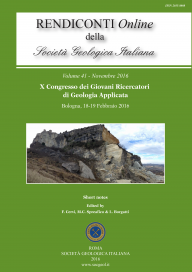
Use of the Conduit Flow Process for the simulation of passive mitigation measures against the piezometric damming effect at the new underground High Speed railway station of Florence
Filippini Maria (a), Martina Mario (b), Menichetti Stefano (c), Palmiero Francesco (a), Ranfagni Luca (c) & Gargini Alessandro (a)
(a) Biological, Geological and Environmental Sciences Dep., Alma Mater Studiorum University of Bologna, Via Zamboni, 67, 40126, Bologna, Italy. E-mail: maria.filippini3@unibo.it
(b) IUSS, Institute for Advanced Study, Pavia, Italy
(c) ARPAT, Regional Authority for Environmental Protection of Tuscany, Florence, Italy
DOI: https://doi.org/10.3301/ROL.2016.92
Volume: 41/2016
Pages: 58-60
Abstract
The new High Speed railway station of the city of Florence will be located below ground level inside a huge excavation, 25 m b.g.s deep, 450 m long and 50 m wide; the pit, already built, is surrounded by concrete cut-off walls causing a piezometric damming effect against the main aquifer of the Arno River. As permanent mitigation measure against the piezometric mounding, the design of the station considers a series of drain pipes drilled horizontally on up and down gradient sides of the pit and connected by blind wall tubes. A numerical finite differences model has been implemented with the Modflow code, in order to quantify the expected damming effect and to properly design the drain-based mitigation measures (i.e. frequency and length of the drains). One of the major challenges of the numeric approach was the coupling between the groundwater flow in the porous medium and the water flow towards and through the drains and the blind wall tubes connecting the sides of the excavation. Thus, the drains were simulated using a recently published Modflow Process originally developed for karst conduits (Conduit Flow Process – CFP), which allows combining the groundwater flow in the porous medium with laminar or turbulent flow into pipes. In order to guarantee an acceptable head differential between both sides of the excavation, the results showed that the system should permit a discharge flow rate of about 0.026 m3/s, considering a hydraulic gradient equal to 0.5% (i.e. hydraulic gradient from the averaged piezometric distribution before pit excavation). Conductance turned out to be the most influent parameter towards the effectiveness of the drainage system.
Keywords
Get Full Text